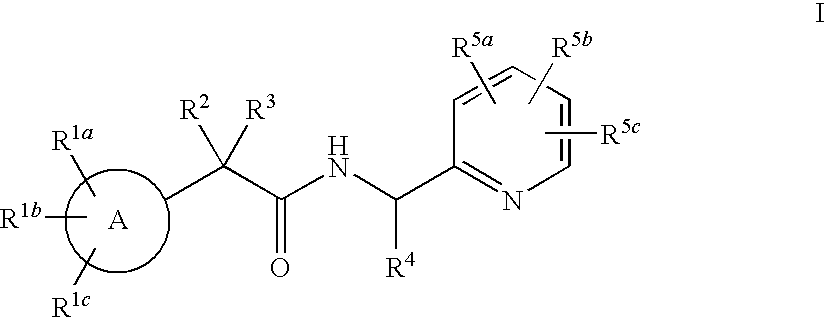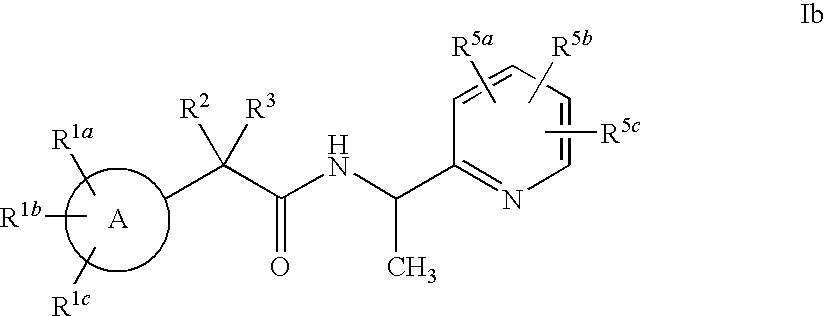Heterocycle amide t-type calcium channel antagonists
a calcium channel antagonist and heterocyclic amide technology, applied in the field of voltage gated channel proteins, can solve the problems of numerous problems in the known therapeutic regimen of such diseases and disorders, and achieve the effect of treating or preventing
- Summary
- Abstract
- Description
- Claims
- Application Information
AI Technical Summary
Benefits of technology
Problems solved by technology
Method used
Image
Examples
example 1
[0450]
2-(1-benzofuran-5-yl)-N-{(1R)-1-[5-(2,2,2-trifluoroethoxy)pyridin-2-yl]ethyl}acetamide
[0451]To a small vial equipped with a magnetic stir bar were added 1-benzofuran-5-ylacetic acid (Meyer, M. D. et. al. J. Med. Chem. 1997, 40, 1049) (29 mg, 0.17 mmol), (1R)-1-{(5-[(2,2,2-trifluoroethyl)oxo]pyridin-2-yl}ethylamine dihydrochloride (48 mg, 0.17 mmol), 1-(3-dimethylaminopropyl)-3-ethylcarbodiimide hydrochloride (35 mg, 0.18 mmol), 1-hydroxy-7-azabenzotriazole (25 mg, 0.18 mmol) and diisopropylethylamine (0.072 ml, 0.41 mmol) into 0.5 ml of DMF. The resulting solution was stirred at room temperature for 1 hour. The reaction mixture was purified by reverse-phase HPLC to give 2-(1-benzofuran-5-yl)-N-{(1R)-1-[5-(2,2,2-trifluoroethoxy)pyridin-2-yl]ethyl}acetamide as a TFA salt. 1H NMR (CDCl3, 400 MHz) δ 8.25 (d, J=2.4 Hz, 1H), 7.62 (d, J=2.0 Hz, 1H), 7.49 (d, J=1.2 Hz, 1H), 7.46 (d, J=8.4 Hz, 1H), 7.35 (dd, J=2.8, 8.4 Hz, 1H), 7.30 (d, J=8.8, 1H), 7.26 (s, 1H), 7.19 (dd, J=1.6, 8.8 Hz...
example 2
[0452]
2-(2-ethyl-1,3-benzoxazol-5-yl)-N-{(1R)-1-[5-(2,2,2-trifluoroethoxy)pyridin-2-yl]ethyl}acetamide
[0453]To a small vial equipped with a magnetic stir bar were added (2-ethyl-1,3-benzoxazol-5-yl)acetic acid (58 mg, 0.28 mmol), (1R)-1-{5-[(2,2,2-trifluoroethyl)oxo]pyridin-2-yl}ethylamine dihydrochloride (83 mg, 0.28 mmol), 1-(3-dimethylaminopropyl)-3-ethylcarbodiimide hydrochloride (60 mg, 0.31 mmol), 1-hydroxy-7-azabenzotriazole (42 mg, 0.31 mmol) and diisopropylethylamine (0.123 mL, 0.706 mmol) into 2 mL of CH2Cl2 and 0.5 mL of DMF. The resulting solution was stirred at room temperature for 1 hour. The solvent was removed and the residue was purified by reverse-phase HPLC followed by preparative TLC (EtOAc) to give 2-(2-ethyl-1,3-benzoxazol-5-yl)-N-{(1R)-1-[5-(2,2,2-trifluoroethoxy)pyridin-2-yl]ethyl}acetamide (69 mg, 60%) as a white solid. 1H NMR (CDCl3, 400 MHz) δ 8.19 (d, J=2.4 Hz, 1H), 7.56 (d, J=1.6 Hz, 1H), 7.44 (d, J=8.4 Hz, 1H), 7.23-7.19 (m, 2H) 7.16 (d, J=8.4 Hz, 1H), ...
example 3
[0454]
2-quinolin-3-yl-N-{(1R)-1-[5-(2,2,2-trifluoroethoxy)pyridin-2-yl]ethyl}acetamide
[0455]To a small vial equipped with a magnetic stir bar were added quinolin-3-ylacetic acid (Konno, S. et. al. Chem. Pharm. Bull. 1981, 29, 3554) (23 mg, 0.12 mmol), (1R)-1-{5-[(2,2,2-trifluoroethyl)oxo]pyridin-2-yl}ethylamine dihydrochloride (36 mg, 0.12 mmol), 1-(3-dimethylaminopropyl)-3-ethylcarbodiimide hydrochloride (24 mg, 0.12 mmol), 1-hydroxy-7-azabenzotriazole (17 mg, 0.12 mmol) and diisopropylethylamine (0.054 ml, 0.31 mmol) into 0.5 ml of DMF. The resulting solution was stirred at room temperature for 1 hour. The reaction mixture was purified by reverse-phase HPLC to give 2-quinolin-3-yl-N-{(1R)-1-[5-(2,2,2-trifluoroethoxy)pyridin-2-yl]ethyl}acetamide as a TFA salt. 1H NMR (CDCl3, 400 MHz) δ 9.17 (d, J=2.0 Hz, 1H), 8.78 (s, 1H), 8.34 (m, 2H), 8.07 (d, J=8.4 Hz, 1H), 7.99 (dd, J=0.8, 8.0 Hz, 1H), 7.83 (d, J=8.0, 1H), 7.43-7.38 (m, 2H), 5.08 (q, J=6.8 Hz, 1H), 4.46 (q, J=8.0 Hz, 2H), 3.90 ...
PUM
| Property | Measurement | Unit |
|---|---|---|
| Pharmaceutically acceptable | aaaaa | aaaaa |
Abstract
Description
Claims
Application Information
 Login to View More
Login to View More - R&D
- Intellectual Property
- Life Sciences
- Materials
- Tech Scout
- Unparalleled Data Quality
- Higher Quality Content
- 60% Fewer Hallucinations
Browse by: Latest US Patents, China's latest patents, Technical Efficacy Thesaurus, Application Domain, Technology Topic, Popular Technical Reports.
© 2025 PatSnap. All rights reserved.Legal|Privacy policy|Modern Slavery Act Transparency Statement|Sitemap|About US| Contact US: help@patsnap.com



